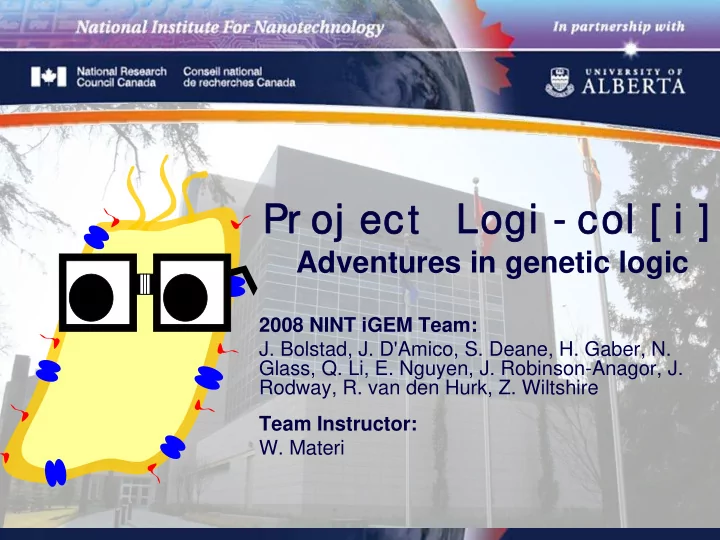

Pr oj ect Logi - col [ i ] Pr oj ect Logi - col [ i ] Adventures in genetic logic 2008 NINT iGEM Team: J. Bolstad, J. D'Amico, S. Deane, H. Gaber, N. Glass, Q. Li, E. Nguyen, J. Robinson-Anagor, J. Rodway, R. van den Hurk, Z. Wiltshire Team Instructor: W. Materi
Pr oj ect Logi - col [ i ] Pr oj ect Logi - col [ i ] 2008 NINT iGEM Team The 2008 NINT iGEM Team
Electronic logic 1 1 Input 1 Input 1 1 Sum 1 2 2 2 Input 2 Sum 1 Input 2 Input 1 Input 2 Output 1 XOR XOR 0 0 0 3 XOR1 Cin 1 0 0 1 Input 1 0 1 0 1 2 Out 1 Carry 2 1 1 1 2 Input 2 AND AND AND 1 Carry 2 OR AND
What could we build with genetic logic? Anderson et al. 2006 Bacteria that New organisms Inexpensive houses target metastatic with controlled from engineered tumors structure plants
Genetic equivalence to electronic logic? Biological systems Electrical systems Connectivity Extensibility
The problem with current approaches � Controls transcription through activator/repressor proteins � Requires specific protein - DNA interaction � Protein engineering is still in its infancy
The problem with current approaches Biological systems Electrical systems Connectivity Extensibility
Terminator/Attenuator anti-sense Logic (T/AasL)
Transcription is a complex, regulated process promoter sequence copied DNA strand 3’ 5’ 5’ 3’ RNA polymerase Transcription
RNA regulation of transcription 3’ U-rich region mRNA 3’ RNA polymerase 5’ Stem-loop structure Terminator at start of transcript = Attenuator Transcription Termination
Principles of T/AasL Output RNA is input to Anti-sense RNA T/A gate the next T/A system Disrupted T/A gate, transcription proceeds
Principles of T/AasL •Predictable structure allows simple design of multiple logic gates that are – Connectable – output and input are same – Extensible – rational design algorithms based on thermodynamic principles – A complete implementation of PoPs!
Logic Gate Design
Prediction of T/A stability • Based on M-fold algorithm • Can process 4 interacting strands of RNA
Stability of stem loop structures: • # nucleotides in loop • type of nucleotides in loop E: -11.6 kJ/mol E: -10.5kJ/mol • length of stem • %GC content in stem E: -7.2 kJ/mol E: -11.7kJ/mol
Design of T/AasL gates: A B Out 0 0 0 AND Gate 1 0 0 0 1 0 1 1 1 A T T T A B T T
T/aT/aaT sequences aaT T aT anti-anti-Terminator Terminator anti-Terminator • aaT & aTs not followed by UA rich region • Relative stabilities affect equilibrium
Design of T/AasL gates: A B Out 0 0 0 1 0 1 OR Gate 0 1 1 1 1 1 A aaT T aT A B aaT aaT T B Requires aaT > aT > T
Design of T/AasL gates: A B Out 0 0 1 NAND Gate 1 0 1 (The Universal gate) 0 1 1 1 1 0 A B aT aT aT aT A B A B B aT aT T A Cryptic terminator sequence Requires aT > T
From logic gates to plasmids…
Connecting devices
Connected plasmids XbaI XbaI TA1 EcoRI EcoRI TA2 … … TA2In TA3In Device 1 Device 2 SpeI SpeI PstI PstI
Input test harness ara
Input test harness plasmid araC TA1 XbaI P BAD EcoRI HindIII TA2In Device 1 XhoI SpeI PstI
Output test harness LacZ α
Output test harness plasmid BamHI araC XbaI XbaI P BAD EcoRI EcoRI NcoI TA2 HindIII TA2In TA3In Device 1 Device 2 LacZ α XhoI SpeI SpeI PstI PstI
Experimental Results
What is the best way to disrupt a T/A?
What is the best way to disrupt a T/A? Reporter Ratio 2.70 2.38 2.46
Expected results (single input gates): 100 90 Relative LacZ Activity 80 70 60 N o input 50 Input 40 30 20 10 0 TRUE his Synthetic anti-Terminator
LacZ assay - terminator efficiency anti-terminators 900 “Improved” synthetic gates TRUE no pause (always ON) 800 with 700 pause 600 Miller Units 500 Synthetic + pause 400 His term His term (THRU) 300 + pause 200 100 0 2111 2121 2021 2031 2041 2051 2061 2071 2081 2091 2101 Construct
Terminator efficiency and stability No correlation 1.00 Relative terminator efficiency 0.75 0.50 0.25 0.00 -80 -70 -60 -50 -40 -30 -20 -10 0 -0.25 Terminator stability (kcal/mol)
LacZ assay - anti-sense activation No activation – but we have some more ideas 2 1.5 Activation ratio 1 0.5 0 2021 2031 2041 2051 2061 2071 2081 2091 2101 2111 2121 Construct
Future Directions and Final Thoughts
Version 1.2 (based on Isaacs et al., 2004) anti-sense input YUNR sequence Bulges in stem T/A gate 2º structure
Future research •Version 1.2 of gates and anti-sense input •Design and characterize dual input devices •Implement OR, AND and NAND gates •Design and implement XOR gate •Connect devices into more complex circuits •Full adder circuit 1 Input 1 2 2 Input 2 Sum 1 XOR 3 XOR1 Cin AND 1 Carry 2 OR AND
Summary •Modeling •stem-loop stability •multi-input T/A gates •Experimental Research •Natural and synthetic terminator efficiency •Anti-sense disruption efficiency •26 BioBrick parts submitted •Designed a viable PoPs implementation
Conclusion - a viable PoPs design T/AasL Electrical systems Connectivity Extensibility
Acknowledgements: Our sponsors: And a special thanks to our team instructor, Dr. Wayne Materi
Thank you!
Input test harness plasmid (with hammerhead ribozymes) araC XbaI P BAD EcoRI RNA Cleavage HH1 HindIII TA2In Device 1 XhoI HH2 SpeI PstI Taira et al., 1991
RNA aptamer regulation of translation Bayer and Smolke, 2005
Recommend
More recommend